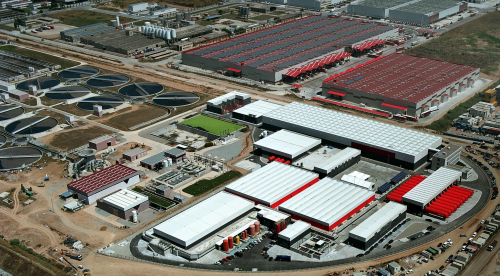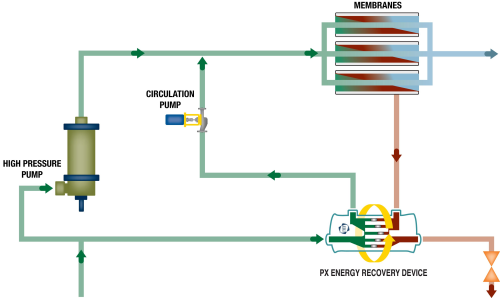

Over the past decade, the city of Barcelona has endured lengthy spells of severe drought, creating serious water shortages. In 2008, Catalunya took emergency measures to supply its residents with potable water. At one point, the government placed major restrictions on the use of water for swimming pools and ordinary landscape irrigation. In desperation, the government transported much needed water by boat from as far as Tarragona and Marseille, to increase reservoir levels for the 4.5 million people in the Barcelona area; the endeavor was costly and unsustainable.
In order to ensure a secure a reliable water supply, the government explored many possible solutions and decided that seawater reverse osmosis (SWRO) desalination was the most viable, long-term option. The initial decision to construct a desalination facility created concerns amongst environmental activists. To address apprehensions, the local Barcelona government conducted thorough research and planning to ensure that a large desalination facility would not impact the environment, and the project moved forward.
Plant supplies fresh water
With a capacity of 200,000 m³/day (52.8 million gallons/day), the plant is currently the largest of its kind in Europe, fully operational since July 2009. Located on the left bank of the LLobregat Delta, alongside the Baix Llobregat Wastewater Treatment Plant, the Barcelona (Llobregat) Desalination Plant was constructed and commissioned within two years. Built on behalf of Aigües Ter Llobregat (ATLL) by a consortium of Aguas de Barcelona (AGBAR), Dragados, DRACE Medioambiente and Degremont, the plant will deliver water to an estimated 1.5 million residents in the region, accounting for about 20% of the area’s water supply.
Intake and pretreatment process
The complete project of the Barcelona (Llobregat) Desalination Plant encompasses the seawater intake, the underwater pipeline to the pumping station, the pipeline between the pumping station and the desalination plant, the pumping of treated water to the Aguas del Ter Llogregat (ATLL) tank, and the reject water pipeline back into the existing seawater outfall of the Baix Llobregat Wastewater Treatment Plant.
The seawater open intake consists of two circular concrete towers built at 30 m below sea level and 2.2 km away from the coastline. Two 1.8 m diameter pipes burrowed in the seabed transport the raw water from the towers to the intake station located on the coast – a distance of 2.5 km from the desalination plant.
Before entering the pumping station tank, the seawater passes through mesh screeners with a mesh size of 23 mm. Then the raw water is stored in an intermediate tank before being pumped by five centrifugal pumps to the desalination plant. On the way to the desalination plant, the pipe transporting the seawater crosses underneath the Llobregat River and several minor hydraulic channels, including the airport wastewater drain.
Prior to the reverse osmosis process, the raw water from the intake undergoes extensive pretreatment to ensure that it arrives in optimal condition before entering the membranes. The Barcelona pre-treatment process includes a special, triple-treatment method, a key feature to maintaining longer membrane life. The contractor employed a triple filtration system to eliminate any impurities, removing algae and pathogens.
From the pumping station, the water enters four automatic screeners with 3 mm mesh size. Then the water is conducted to the coagulation and flotation chambers, and on to the dual media gravity filters. Finally, it goes to the pressurized dual media filters and cartridge filters, before feeding into the RO first pass trains.
A biocide (sodium hypochlorite) used to eliminate bacteria and prevent biofouling is added into the seawater tank, while sulfuric acid is used to adjust the pH of the seawater. Ferric chloride is used as a coagulant before the coagulation chambers and the dual media pressurized filters.
Plant uses PX technology
The Barcelona (Llobregat) Desalination Plant is configured into two production lines, each with a capacity of 100,000 m³/day. The plant consist of two passes, the 10 first pass trains have a nominal capacity of 20,500 m³/day and a partial second pass of two trains, each have a nominal production rate of approximately 16,500 m³/day. Each of the 10 trains is fitted with pressure equipment. This includes 230 Energy Recovery PX-220 devices, with 23 PX devices installed in each train.
ERI energy recovery technologies, including the PX Pressure Exchanger devices, are ceramic devices which use just one moving part to recycle energy (from SWROs high-pressure waste stream) at up to 98% efficiency. PX Pressure Exchanger devices use the principle of positive displacement and isobaric chambers to achieve efficient transfer of energy from a high pressure waste stream, such as the brine stream from a reverse osmosis desalination process, to a low-pressure incoming feed stream (seawater). The ERI PX Pressure Exchanger device captures energy from the waste stream of seawater desalination, and recycles it back into the plant’s operations. The device pumps approximately 50 m³ of briny water an hour.
ERI devices required no customization for the Barcelona plant, offering maintenance-free operations, an ideal advantage for owners and operators looking to reduce lifecycle costs. The implementation of this energy-efficient PX technology and disposal of the brine is key to the environmental viability of this award-winning facility. While SWRO desalination is a historically energy-intensive process, this Barcelona facility relies on isobaric energy recovery devices to cut the energy consumed by the SWRO process – estimated to save 22.5 MW of energy.
To ensure that the brine from desalination is disposed of in a manner that is not harmful to the environment, it is mixed with the pure treated water from the adjacent Baix Llobregat Wastewater Treatment Plant before being discharged back into the sea. This allows a dilution of the brine, which further decreases any environmental impact the brine could have caused.
Post-treatment
In order to adapt its quality to that of drinking water, the permeate water undergoes a re-mineralization process. This consists of passing the water through a number of calcite (CaCO3) beds with a total surface area of 672 m² and dosing with carbon dioxide (CO2) to re-establish lime-carbon dioxide equilibrium of the water. The water is then evacuated by spillway into the treated tank under the calcite beds. Chlorine dioxide is injected to ensure disinfection, and the water is then suctioned by the treated water pumps and sent to the Fontsana tank in the municipality of San Joan Despi. This is the delivery point for the ATTL network.
With the success of the Barcelona (Llobregat) Desalination Plant, several other desalination projects are now underway in Catalunya and throughout Spain to guarantee the region a consistent supply of fresh water for the future.





